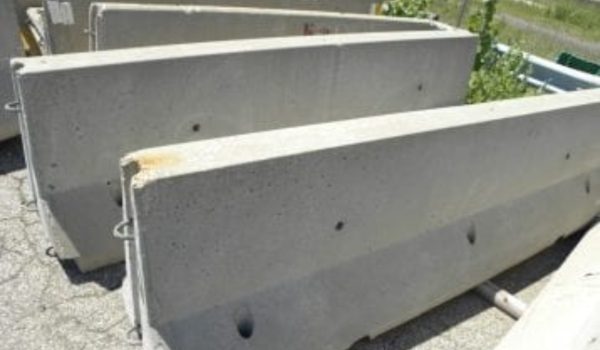Grading Used Concrete Barriers
Understanding the grading of used concrete barriers is crucial before deciding to purchase. Our inventory consists of new and used barriers. Used barriers are categorized into grades based on their physical condition, appearance, and functional longevity. This grading system ensures that you can select barriers that best meet the specific needs and budget constraints of your project.

A GRADE
A Grade barriers represent the highest quality in our used inventory. These barriers exhibit no full-thickness cracks and may have minor cosmetic damage, such as small missing chunks no larger than a baseball. The paint on these barriers is generally minimal, displaying mostly their original gray color, which suggests minimal exposure to the elements. Their surface is more smooth than weathered, indicating that they have been in use for approximately 6 months to 2 years. A Grade barriers are ideal for projects requiring a neat appearance with high structural integrity.

B GRADE
B Grade barriers are a step down in cosmetic appearance but still maintain structural integrity. These barriers have no full-thickness cracks but may show some surface cracks and have chunks missing, though nothing larger than a soccer ball. They often have less than 50% of their surface painted, with possible peeling, giving them a more weathered look than A Grade barriers. Typically, these have been used for 2 to 5 years and are suitable for projects where aesthetics are less critical but durability is still important.

C GRADE
C Grade barriers show more significant signs of wear and use. They have cracks that may go up to 75% through the barrier and commonly have larger chunks missing, up to the size of a basketball. These barriers often feature a lot of peeling paint and have a thoroughly weathered texture, reflecting their use in the field for anywhere from 2 to 10 years. C Grade barriers are functional where structural integrity remains critical, but visual appearance is of least concern.
Utility Grade
Utility Grade barriers are the most worn and are only recommended for specific applications where aesthetics and partial structural integrity are not a concern. These barriers may have full-thickness cracks, large missing chunks, and a heavily weathered texture. Some might not stand independently and show considerable rebar exposure, making them suitable only for certain types of containment or temporary applications. Their years of use are generally unknown, and they are priced at a steep discount, negotiable based on the condition.
Ordering and Selection Process
When placing an order for used concrete barriers, you can typically expect a mix predominantly of B grades, with some C grades included. We ensure that no Utility grade barriers are shipped unless specifically requested due to their varied condition. If your project requires a uniform quality, such as all A Grade barriers, we offer a hand-selection service to meet your specific needs. This service allows you to tailor your order to ensure that the barriers you receive align with your project’s structural and aesthetic requirements.
Conclusion
Choosing the right grade of used concrete barriers can significantly impact the cost-effectiveness and success of your project. By understanding the distinctions between each grade, you can make informed decisions that balance your project’s needs with your budget. Whether you require the near-pristine appearance of A Grade barriers or the functional, cost-saving options of lower grades, our grading system is designed to meet diverse project demands efficiently and transparently.
